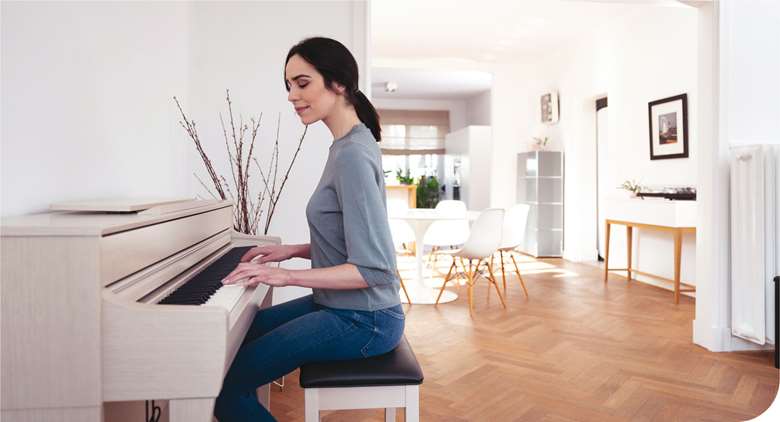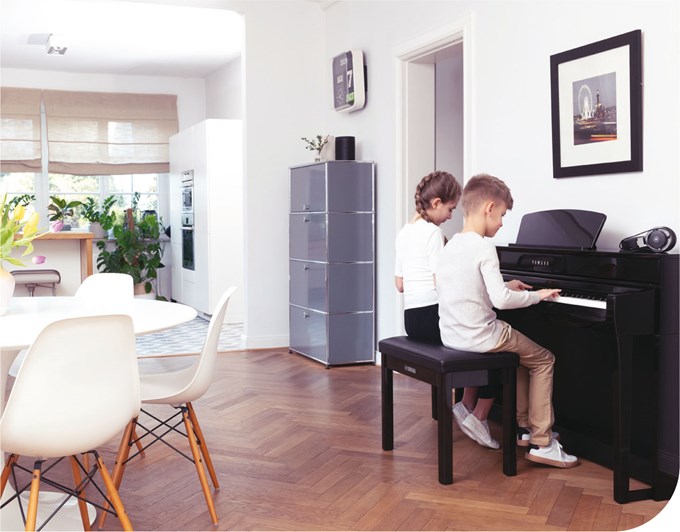The new Clavinovas from Yamaha: Do they deliver?
Murray McLachlan
Sunday, November 1, 2020
Yamaha's new CLP-700 series promised much, so we asked Murray McLachlan to go to Yamaha's UK HQ to find out if they deliver.

In 2016, Time magazine included the Clavinova as one of the top 50 most influential gadgets of the 21st century, the only musical instrument on a list that included the iPhone, Walkman and iPod. They were launched in 1985 by Yamaha and though initial models had an artificial tonal range and poor keyboard action, they were instantly welcomed by schools and individuals in search of instruments that were economical, did not need to be tuned, and that were compact in terms of space.
In 35 years, the product has become part of our cultural consciousness, having had a profound impact on music education in all kinds of schools as well as a huge influence on home music making.
In terms of electronic instruments offered by Yamaha, the Clavinova sits midrange between starter instruments – the Arius range, available at most Yamaha dealers – and the Avant Grand hybrid piano series, which uses real piano action. Whereas the Arius instruments are very much geared towards novice players and individuals who are not primarily interested in piano playing per se, the much more expensive Avant Grand series can be considered more of a specialist category. Clavinova holds its own in the mid-ground between Arius and Avant Grand.
The new range
The freshly launched 2020 CLP range currently has six models. As I had two hours to try out the new range of instruments at Yamaha's UK headquarters in Milton Keynes, I immediately tried out slow and cantabile excepts from Chopin and Rachmaninov as a challenging test for each model. Traditionally it is in the nocturnal, meditative repertoire that digital instruments have been most artificial and unsatisfying when compared to acoustic instruments. What immediately struck me was how impressive the pedalling devices are throughout the range. It is easy to flutter and half pedal, though as yet there is no change to the una corda device, which you either put down or take off (some pianists, myself included, are convinced that there are tonal differences possible depending on how fully down the una corda is depressed). All these new models have the same essential sounds, but they get controlled in a progressively more advanced way from the cheapest to the most expensive instrument.
Touch and tone quality
I was deeply impressed by the touch and control that was possible. The 2020 Clavinova has two specific actions designed for it. The GrandTouch-S is fitted to the lower models, while the higher models get the more sophisticated GrandTouch action. The attention to detail is impressive, with a graded hammer action meaning notes at the bottom of the keyboard feel heavier than at the top. Higher models take this still further, with every key being individually weighted. The escapement feel of the action has also been refi ned for this new series.
The new instruments have gone much further than before in terms of dynamic sampling, making tonal variety much easier to achieve. They use a three-sensor action, with sensors positioned at the top, middle and bottom of each key. This has a huge impact on touch control, allowing for higher repetition speed in execution as well as for possibilities of partially retaking repeated notes, and not having to find an artificially fixed point of escapement in order for notes to ‘speak’ reliably. It was wonderful to experiment in all six models with touch control, and to feel confident that it was possible for me to feel in control when depressing notes three-quarters of the way down as well as halfway down. As all pianists know, this is a crucial technical consideration, and one that can make all the difference for long term, sustained practising and playing.
Top of the range
The top new models utilise transducer speakers (as do the Avant Grand instruments), which make use of cabinet resonance, meaning that the instrument's body resonates in a manner that is more convincingly similar to acoustic instruments than mere volume control on its own would allow.
The two new flagship models are the upright CLP-785 and grand CLP-795GP. They are identical terms of what they offer technologically and are both beautiful instruments, with high-gloss polyester cabinets (the CLP-785 is also available in a satin finish). They offer two main piano sounds: a Yamaha CFX and a Bösendorfer Imperial Grand. Both of which have been resampled for these instruments, adding layers and extra dynamics, meaning that there is less electronic manipulation. As one would expect, the CFX sound is very bright, with lots of bass, whilst the Bösendorfer is darker and richer, with a more mellow treble. Also included are four historic pianos: a so called ‘Scarlatti’ piano (clearly emulating the pioneering Cristofori instrument), a ‘Beethoven piano’ (emulating the composer's Broadwood instrument), a ‘Mozart piano’ (after the composer's Walter model) and a ‘Chopin piano’ (after the composer's Pleyel). It is fascinating and educationally extremely helpful to be able to immediately access sounds that emulate the instruments that the great composers may well have had in mind when they were composing. The sounds are taken directly from instruments in the Hamamatsu Museum of Musical Instruments. Although not all of the four historic options are available throughout the new Clavinova range, the cheapest models still include the Walter and Pleyel sounds.
Speakers and technology
In addition to conventional speakers, the top three instruments (the 795GP, 785 and 775 models) use transducers, which exploit vibrations picked up in the cabinet of the instrument. The speakers on the 785 and 795GP models use spruce wood cones rather than conventional paper, which gives a slightly warmer and more ‘acoustic’ sound.
The new models seek to avoid the perception of the sound coming from below keyboard level. Yamaha's ‘grand acoustic imaging’ method means that the speakers are distributed at different positions around the instrument, so that there is less of a fixed perception about where the sound is coming from.
There are all kinds of technological sensitivities that are present in the new range that make a huge difference. These instruments consider sounds and noises that would come from all the different parts of an acoustic model, including the dampers, the stringing and the soundboard. They make use of new VRM technology (virtual resonance modelling), and this has had subtle and notable effects on the realism of the sound.
Other exciting features include adjustable reverberation, ranging from ‘room level’ to the ‘recital’ and ‘cathedral’ sounds, the latter extremely resonant and quasi Royal Albert Hall in terms of delivery! The sounds are binaural for use with headphones. If you are listening through headphones you can choose to turn the VRM modifications on or off. Producing the sounds and analysing how the sounds are perceived has taken literally thousands of hours of testing and retesting, using dummy heads (with mics on either side of each ‘eardrum’) as well as data received from the perceived responses of around one hundred individual volunteers.

Personal preferences
Press a button marked ‘piano room’ on the control panel and you can make unbelievably subtle modifications according to your preferences and tastes. You can adjust the position of the lid to full, half stick or closed, and through ‘my virtual technician’ you can adjust the brightness and experiment with voicing by adjusting the hammer positions. You can alter the tuning system if you are unhappy with the default ‘equal temperament’ choice by choosing from a range of six – or make your own bespoke tuning system. And you can even adjust the touch so that it will appear as though it requires more physical effort to play forte – even though in practice, like so many of these ‘alterations’, the differences are affected by our perceptions. Most excitingly, the new clavinovas work with the app ‘Smart Pianist’, which allows users to store their chosen preferences for touch, tuning and so on, and then apply them at the touch of a button to a whole series of instruments. This could really prove invaluable to teachers travelling between different instruments in schools who will be able to restore each one to settings of their choice.
Elegance and discretion
The electronic display on larger models is hidden from view during normal playing – simply tap with your finger and it ‘wakes up’, much like your mobile phone screen, only to fade to black when you have finished setting your preferences.
The pedals and hinges have a classy silver colouring on many finishes, and there is a wide variety of different finishes available, from classic ‘piano black’ gloss through to a modern white ash satin. I was especially pleased to see a longer music stand complete with a hinge and clips to keep sheet music in place. From the CLP-745 upwards the instruments use wood rather than plastic for the keys.
Recording and extras
There are many other electronic innovations and features in the new Clavinova range, and they come with all the usual electronic paraphernalia, including organ, string, and bass sounds. Other features include a metronome device with 15–20 different stylistic options to keep you in time via drum kits and so forth. It can even recognise chords so that you can be given a bass line as well as a drum kit backing and feel as though you are the keyboardist in a jazz trio, if that takes your fancy!
You can record your performance in MIDI format for use with scorewriting software such as Sibelius or Dorico, or sequencing software such as Cubase. You can also record in WAV audio format at CD-quality sound, making it easy to burn a CD in minutes.
The CLP745 models upwards are equipped with Bluetooth and so can play anything streamed to them from your tablet or device, meaning that they can be used as a conventional audio system, which is very useful in a classroom situation.
The verdict
In sum, I cannot express enough enthusiasm for these new digital pianos. We are all used to new digital instruments coming on the market with a bewildering array of electronic innovations, apparently turning pianos into quasi-computers. What is so refreshing about this new range is that Yamaha is clearly placing musical needs first. Sound and touch are prioritised over technological novelties. For musicians, teachers, and amateur players the range is both creatively inspirational as well as economically practical.
Explore the full range at europe.yamaha.com.

